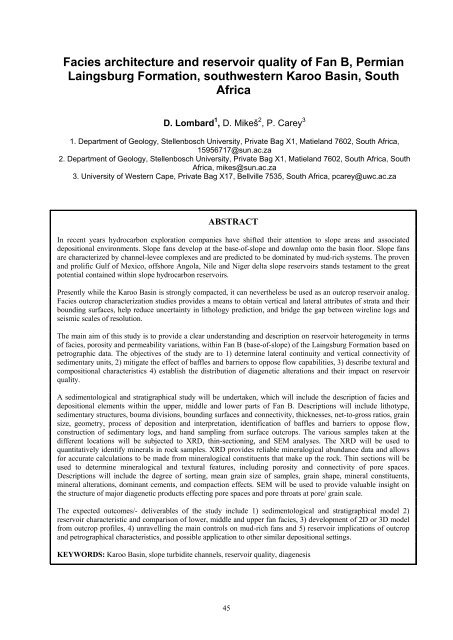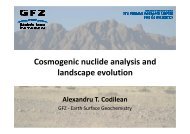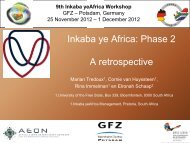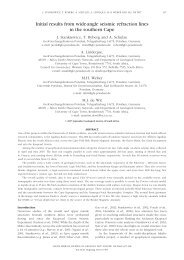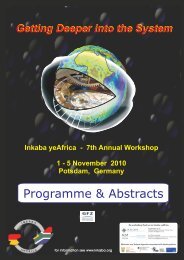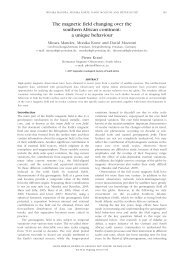South Africa - Inkaba.org
South Africa - Inkaba.org
South Africa - Inkaba.org
You also want an ePaper? Increase the reach of your titles
YUMPU automatically turns print PDFs into web optimized ePapers that Google loves.
Facies architecture and reservoir quality of Fan B, Permian<br />
Laingsburg Formation, southwestern Karoo Basin, <strong>South</strong><br />
<strong>Africa</strong><br />
D. Lombard 1 , D. Mikeš 2 , P. Carey 3<br />
1. Department of Geology, Stellenbosch University, Private Bag X1, Matieland 7602, <strong>South</strong> <strong>Africa</strong>,<br />
15956717@sun.ac.za<br />
2. Department of Geology, Stellenbosch University, Private Bag X1, Matieland 7602, <strong>South</strong> <strong>Africa</strong>, <strong>South</strong><br />
<strong>Africa</strong>, mikes@sun.ac.za<br />
3. University of Western Cape, Private Bag X17, Bellville 7535, <strong>South</strong> <strong>Africa</strong>, pcarey@uwc.ac.za<br />
ABSTRACT<br />
In recent years hydrocarbon exploration companies have shifted their attention to slope areas and associated<br />
depositional environments. Slope fans develop at the base-of-slope and downlap onto the basin floor. Slope fans<br />
are characterized by channel-levee complexes and are predicted to be dominated by mud-rich systems. The proven<br />
and prolific Gulf of Mexico, offshore Angola, Nile and Niger delta slope reservoirs stands testament to the great<br />
potential contained within slope hydrocarbon reservoirs.<br />
Presently while the Karoo Basin is strongly compacted, it can nevertheless be used as an outcrop reservoir analog.<br />
Facies outcrop characterization studies provides a means to obtain vertical and lateral attributes of strata and their<br />
bounding surfaces, help reduce uncertainty in lithology prediction, and bridge the gap between wireline logs and<br />
seismic scales of resolution.<br />
The main aim of this study is to provide a clear understanding and description on reservoir heterogeneity in terms<br />
of facies, porosity and permeability variations, within Fan B (base-of-slope) of the Laingsburg Formation based on<br />
petrographic data. The objectives of the study are to 1) determine lateral continuity and vertical connectivity of<br />
sedimentary units, 2) mitigate the effect of baffles and barriers to oppose flow capabilities, 3) describe textural and<br />
compositional characteristics 4) establish the distribution of diagenetic alterations and their impact on reservoir<br />
quality.<br />
A sedimentological and stratigraphical study will be undertaken, which will include the description of facies and<br />
depositional elements within the upper, middle and lower parts of Fan B. Descriptions will include lithotype,<br />
sedimentary structures, bouma divisions, bounding surfaces and connectivity, thicknesses, net-to-gross ratios, grain<br />
size, geometry, process of deposition and interpretation, identification of baffles and barriers to oppose flow,<br />
construction of sedimentary logs, and hand sampling from surface outcrops. The various samples taken at the<br />
different locations will be subjected to XRD, thin-sectioning, and SEM analyses. The XRD will be used to<br />
quantitatively identify minerals in rock samples. XRD provides reliable mineralogical abundance data and allows<br />
for accurate calculations to be made from mineralogical constituents that make up the rock. Thin sections will be<br />
used to determine mineralogical and textural features, including porosity and connectivity of pore spaces.<br />
Descriptions will include the degree of sorting, mean grain size of samples, grain shape, mineral constituents,<br />
mineral alterations, dominant cements, and compaction effects. SEM will be used to provide valuable insight on<br />
the structure of major diagenetic products effecting pore spaces and pore throats at pore/ grain scale.<br />
The expected outcomes/- deliverables of the study include 1) sedimentological and stratigraphical model 2)<br />
reservoir characteristic and comparison of lower, middle and upper fan facies, 3) development of 2D or 3D model<br />
from outcrop profiles, 4) unravelling the main controls on mud-rich fans and 5) reservoir implications of outcrop<br />
and petrographical characteristics, and possible application to other similar depositional settings.<br />
KEYWORDS: Karoo Basin, slope turbidite channels, reservoir quality, diagenesis<br />
45


